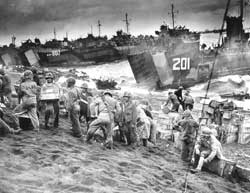| The War in the Pacific |
|
|
Iwo Jima With the major points in the Philippines secure, the Allies began looking to the final assault on the Japanese islands. Along the route lay Iwo Jima, an island less than four miles long and just over two wide. Allied planners believed the capture of this volcanic island would ease the later operations because it could be used as an emergency air base for crippled heavy bombers returning from missions over Japan. Furthermore, fighters could fly from Iwo Jima and could supply cover for the entire distance to the targets and back.
Nine hundred vessels sailed in the numerous task groups of the Fifth Fleet and in support of the operation. These ships carried expeditionary forces of more than 70,000 Marines, nearly 4,000 men in the naval landing force, and more than 36,000 garrison troops to attack the determined Japanese of 21,000. The Allies set Feb. 19 as D-Day. The assault forces arrived off the southeast side of the island to land men at seven predetermined beaches stretching only 3,500 yards. Included in these vessels were the Bayfield and the Callaway, 14 LSTs, and the submarine chaser PC-469. With no reefs surrounding the island, the landings promised little difficulty. The attack forces arrived off the beaches before daylight and began debarking troops into the LVTs, and lowered LCMs and LCVPs for the assault. The LVTs landed the first five assault waves. The anticipated good beach conditions unfortunately did not materialize. The surf broke directly on the beach, broaching and carrying the small craft sideways up on the beach. It did not take long for the shore line to become littered with craft. The successive waves of landing craft had difficulty getting to the beach and likewise became damaged and lost. The Coast Guard coxswains found it necessary to back the craft into the wind and current to keep grounding hard onto the beach. The beachmasters, salvage parties and beach parties normally kept the beaches clear, but due to the intense Japanese mortar fire, none of these men could remain on the beach. Therefore the coxswains in the landing craft had to take all the initiative to get to the beach, unload, and back off. The wreckage eventually caused the beach to be closed to everything smaller than an LCT until tugs and other craft cleared it for later waves to disembark troops and supplies. The Coast Guard landed Marine divisions along with their gear, bulldozers, vehicles, rations, small arms, water, and virtually everything that would keep the landing forces moving inland. One of the most enduring images of the capture of the island is the Marines raising the American flag on Mt. Suribachi. Interestingly both the LST-779 and the LST-758 claimed the honor of suppling one of the flags used during the raising on Mt. Suribachi. |
